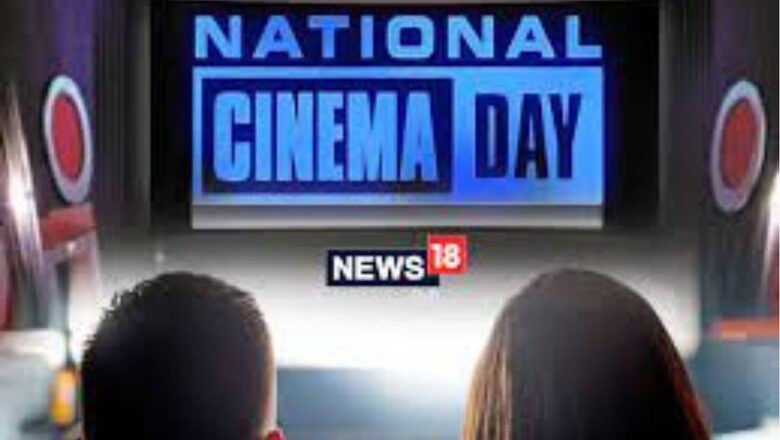
views
On waking up every morning, young Jaya fumbles her way to the cupboard with her eyes closed, feels about for the right book and turns to the right page — and opens her eyes to behold the picture of her hero, film star Jaishankar. This is a scene from the Tamil hit Cinema Paithiyam (1975) which was about a schoolgirl Jaya (played by Jayachitra) enamored of the world of cinema. True, fanboy (and fangirl) adulation for films and film stars in India has few parallels anywhere in the world. Cinema in India is much more than just entertainment. It has mirrored both society and the individual, following as it has the socio-economic and political changes we have sustained.
On National Cinema Day 2023 on October 13, let us explore.
Cinema was one of the voices of the freedom struggle pre-1947, portraying the British as the villain implicitly, often metaphorically. For instance, Padosi (1941) was about an outsider (read Britisher) attempting to divide two good neighbors, Thakur and Mirza. Now, this was unique to India because the American war of Independence happened much before cinema took birth in the US. And Britain was not fighting any war of independence. In an Independent India too it was interesting to observe how the socio-economic contours influenced key features like romance, villainy and music.
The late 1940s and the 1950s were a period of pain with people getting uprooted from their homes. This was reflected in romantic tragedies like Anmol Ghadi (1946), Andaz (1949), Deedar (1951), Daag (1952). With Western music still making its way in, Indian classical music and dance formed a strong base for Jhanak Jhanak Payal Baaje (1957), Basant Bahar (1957) and Baiju Bawra (1952). The bane of caste discrimination showed up Sujata (1959) while economic inequality formed the basis of Pyaasa (1956). Also, scarce employment opportunities in a new India, pushed capable young men like Raj in Awara (1951), Madan in Baazi (1951) and Tony in Jaal (1952) into a delinquent life. Musically, the decade was dominated by that incredible composing duo — Shankar-Jaikishan.
In the 1960s, the travails of hunger and shelter made way for light-hearted musical romances in exotic locations like Kashmir, Darjeeling, Shimla, Tokyo, London, Beirut and Paris. Color technology brightened up the mood even more. On the serious side of life, China and Pakistan became the new foreigner villains in Haqeekat (1964) and Hindustan ki Kasam (1973) for obvious reasons while the License Raj and high import tariffs precipitated the smugglers — both in the country as well as on screen.
Flashy smugglers, hoarders and drug dealers like Teja, Shakaal, Kalicharan, Loin (he meant ‘Lion’) (all Ajit) in Zanjeer (1974), Yaadon ki Baaraat, Charas (1976), Kalicharan (1976) were the unashamed faces of consumerism. Meanwhile in the middle-class homes, the joint family was fast disintegrating aided by home-breaking modern daughters-in-law like Neela (Bindu) in Do Raaste (1969).
RD Burman’s innovative music with a western bias that gelled with leather jackets and fast bikes marked the dawn of the 1970s. His Dum Maro Dum was the anthem of the hippies. His romantic melodies propelled Rajesh Khanna’s superstardom and ‘halted’ Dev Anand from aging. True, music of Abba, Boney M, The Carpenters, Cliff Richard, Beatles, Simon and Garfunkel were liberally borrowed. Just the way that Twist form of dance was, in the 1960s. Or the way Mithun Chakraborty would do the Michael Jackson in the desi-disco era of the 1980s. But anything that trespasses into our domain becomes ours by default. Such is our innate commitment to our cinema.
Copying (sorry, inspiration) wasn’t limited to music. The James Bond series, Chase a Crooked Shadow (1958), It Happened One Night (1934), The Godfather (1972), the western cowboy films, The Sound of Music (1965) … they spared nothing. Forget purchasing the rights, in most cases not even an honorable mention of the source was made of the originals. But there appeared to be an underlying genuineness in the intent behind copying.
The idea was to give the people a taste of world cinema in a language that they could understand. The narratives were garnished with local flavors of dance and music that the audience could connect with. Maybe that is why we had Agent 116 (Jeetendra) in Farz (1967) running and rolling down verdant slopes singing ‘Mast baharon ka main aashiq’. Sean Connery and Roger Moore would have been shaken and stirred on seeing these.
With the economic liberalisation and the software boom in the early 1990s the youngsters’ lifestyles upgraded too. Wealth was health and they celebrated it. This was the profile of the NRI segment that Bollywood smartly targeted in the 1990s. Thus, we see either an overseas backdrop or NRI lead characters like Raj and Simran in Dilwale Dulhania Le Jayenge (1995). At the same time, familial ties and ties to Indian roots of the diaspora were emphasized upon e.g. Pardes (1997) was about not losing one’s Indianness.
Indian cinema is unique. We love to believe in the unbelievable. Everybody knew that it was the voice of T.M. Soundararajan behind the face of MGR. But credit is generously given to both the actor and the playback singer. We didn’t need Superman to bash up a dozen goons because we have seen Amitabh Bachchan do the same repeatedly and we are convinced. Films have achieved what no parochial agenda could deter. Amidst the severe push-back by the southern states on the perceived imposition of Hindi, Yaadon ki Baraat (1973) completed a jubilee run in Madras while Sholay (1975) ran a marathon. Nagesh and Mehmood were spirit brothers — mirroring each other’s hits, with the tandem films Madras to Pondicherry (1966) and Bombay to Goa (1971) being a prime example.
Today we see big budget films releasing simultaneously in Hindi, Tamil and Telugu, shattering the language barrier. Sangeet and Mehndi functions are a must-have in south Indian weddings. How? Yashraj showed the way. Cinema is in our homes. There is a Fan (2016) in us that ranges from the aspirational to the hallucinatory. Why else did young girls ‘marry’ Rajesh Khanna’s photograph in the early 1970s?
There are films, there are films on films like Akaler Sandhane (1980) and there are films within films like Khamosh (1985). There are also classics like Nayak (1966) that peep into the vulnerabilities behind a confident façade of a film star Arindam Mukherjee (Uttam Kumar). We live and breathe cinema every single day.
October 13, 2023, would be a day when we acknowledge this fact once again.
Balaji Vittal is a National Award winning and MAMI Award winning author of Bollywood books, a columnist, a Bollywood commentator and a public speaker. He can be reached on Twitter at @vittalbalaji and his website is www.balajivittal.com. Views expressed in the above piece are personal and solely that of the author. They do not necessarily reflect News18’s views.




















Comments
0 comment